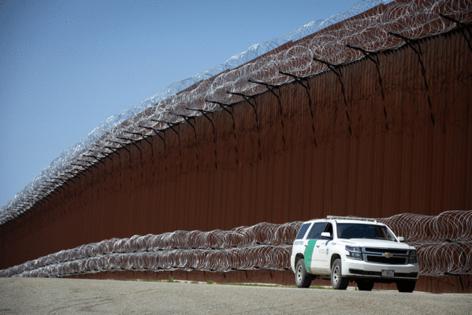Commentary: Immigration spying has inglorious past
Published in Op Eds
In the early 1900s, the U.S. Bureau of Immigration created a special “Chinese Division” to enforce the Chinese Exclusion Act of 1882, which was the first major U.S. immigration law to ban entry based on race and nationality. Federal agents were sent to Mexican border towns and tasked with secretly photographing, tracking and cataloging Chinese migrants — in a word, to spy on them.
Years before the Border Patrol was formally created in 1924, federal officials began patrolling the U.S.-Mexico border to catch Chinese migrants attempting to enter the country. Immigration officers and “mounted Chinese inspectors” on horseback rode through deserts and borderlands, detaining people based on appearance and perceived foreignness.
These mounted officers, often deputized cowboys or former soldiers, were the precursors to today’s militarized border enforcement, practicing racial profiling and exclusion through surveillance and force. The “Chinese Division” later expanded to the “Oriental Division” and the 1917 Immigration Act created a further ban on migrant arrivals from Asia. The vigilante agents used racial profiling to detain migrants from South Asia, Korea and Japan.
More than a century later, the tools have changed, but the xenophobic logic remains the same. The “Big Beautiful Bill” recently signed into law by President Donald Trump apportions roughly $170 billion to increase the surveillance, detention and deportation of migrants. The Department of Homeland Security’s sprawling immigration enforcement network includes U.S. Immigration and Customs Enforcement’s Homeland Security Investigations, Border Enforcement Security Task Forces and intelligence-sharing partnerships with local police.
The task forces rely heavily on data fusion and predictive policing tools built by private surveillance contractors like Palantir, a shadowy tech company that builds data integration tools. These tools mine utility bills, motor vehicle records, social media and cell phone metadata to create digital dossiers on immigrants, without their knowledge or consent.
In 2021, Texas Gov. Greg Abbott launched Operation Lone Star, which has deployed thousands of law enforcement officers and National Guard troops to the border with the intent of criminalizing migrants. The National Guard employs drone technology with thermal imaging and GPS capabilities to “stop illegal crossings.”
Operation Lone Star has turned border counties into militarized zones where asylum seekers are prosecuted en masse and detained for state trespassing charges — a legal loophole designed to bypass federal immigration protections. It echoes the same discriminatory strategy from the 19th century, now upgraded with machine learning and biometric databases.
Palantir’s tools allow ICE to analyze vast amounts of personal data to identify, locate and build cases against immigrants. In some cases, these tools are integrated with facial recognition technology used by law enforcement partners. Studies have shown that this software is less accurate for people of color. These technological flaws can have dire civil rights implications. False matches can mean wrongful arrests, lost jobs and even deportation.
Surveillance doesn’t stop at the border. Across the U.S., cities and counties share data with immigration authorities, often unknowingly. Local law enforcement feeds facial recognition systems. Artificial intelligence-driven policing and surveillance tools have disproportionately impacted immigrant communities, reinforcing bias under the guise of objectivity.
The result is a digital dragnet and seamless system of exclusion that stretches from facial scans at the airport to license plate readers in sanctuary cities. These technologies are often implemented without transparency or oversight. Community members often don’t know they’re being watched, how their data is used or what rights they have.
The “Chinese Division” taught the federal government how to use surveillance as a weapon of exclusion. Operation Lone Star and Palantir show just how far that lesson has been taken. The faces and targeted populations may change, but the underlying assumption is the same: Some people are too foreign to be free.
From mounted inspectors on horseback to AI-powered dragnets, the apparatus may have modernized, but the mission remains chillingly familiar: to mark certain bodies as threats, render their communities invisible and deny people the right to belong.
Surveillance will never make us safer. We cannot allow tools of oppression to be cloaked in a facade of innovation. A nation monitoring its people rather than protecting their rights is not securing its future — it is repeating the failures of its past.
_____
Stephanie Drenka is the co-founder and executive director of the Dallas Asian American Historical Society. She also currently works for the Texas Civil Rights Project, which advocates for immigrants’ rights. This column was produced for Progressive Perspectives, a project of The Progressive magazine, and distributed by Tribune News Service.
_____
©2025 Tribune Content Agency, LLC.

























































Comments